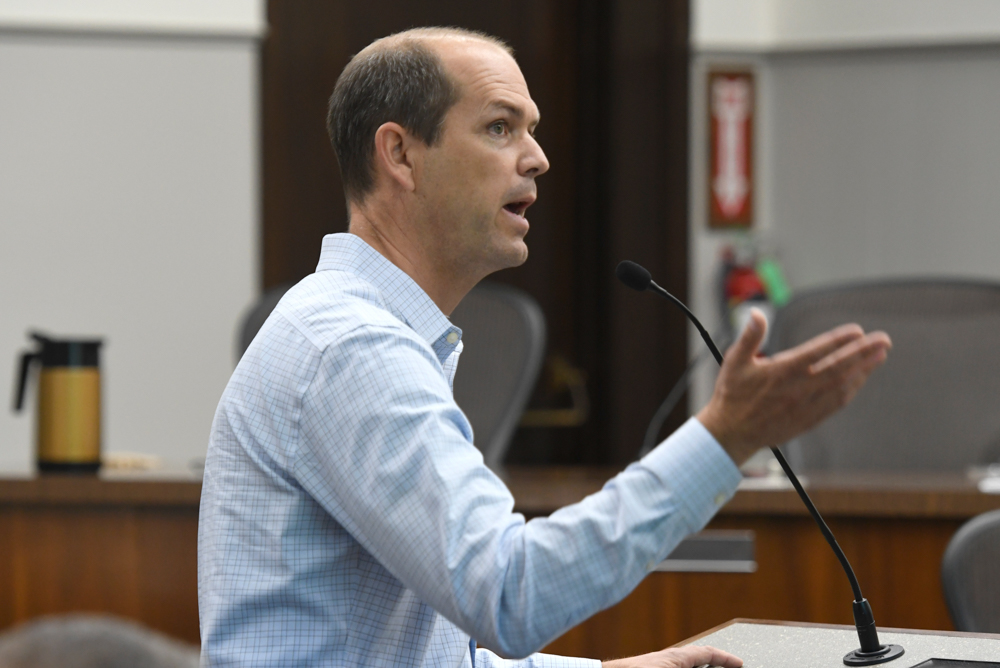Why Won’t Santa Barbara City Council Progressives Fix Broken Housing Plan?
Planning Commissioner Forced to Beg Landlord from Dais

It was a mind-boggling moment. It couldn’t be happening. Yet it was. Deborah Schwartz, a Santa Barbara city planning commissioner for the last eight and a half years, was begging — begging — developer Greg Reitz not to include so many amenities for his proposed downtown rental housing development. If Reitz could find it in his heart not to make his new units quite so nice, Schwartz pleaded from the dais, maybe he wouldn’t feel compelled to demand such high rents from his new tenants. Maybe that way, Schwartz reasoned, the new units wouldn’t be quite so unaffordable for most working Santa Barbarans.
It’s come to this?
Begging and pleading from the dais as public policy?
The short answer is yes.
The longer answer is worse. The only reason Schwartz and the other commissioners find themselves in this embarrassing predicament is because the City Council has repeatedly delayed adopting new rules that would allow City Hall — if not Schwartz herself — to require Reitz to charge less-than-premium rents to a handful of tenants in the middle-income category. Two years ago, the State Legislature passed, and the governor signed, a new law giving cities and counties just this power. It authorized local governments to require that 10-15 percent of new rental units be at rates affordable to “the missing middle.” In Santa Barbara, the “missing middle” includes people making 80-120 percent the Area Median Income (AMI). For a couple, that translates to anywhere from $64,000 to $76,000 a year. Under the new state law, missing-middle rents could not be more than 30 percent the tenants’ income.
In the two years since, our liberal, progressive, Democratic councilmembers have kicked this can down the road so many times their toes are bruised and bloody. First, they created an ad hoc committee that chewed the idea to death — at 11 public hearings. City Hall hired an economic consultant to determine if such requirements “penciled out” economically or whether they’d kill new rental developments with unsustainable costs. The consultant found developers could make an acceptable profit even if 10 percent of their new units were rented at missing-middle rates. It got the Good Housekeeping Seal of approval.
In February, the council — made up ostensibly of fire-breathing affordable-housing advocates — voted to delay further consideration until some indeterminate future date. The Planning Commission, they decided, should weigh in first. Now it’s late September. As of right now, there’s no date set for the Planning Commission to opine. Before that can happen, I am informed, various and sundry public meetings and workshops must be held. For the record, such hearings are neither required nor customary.
If one were suspicious, one might wonder what’s really going on.
Let’s go back to Greg Reitz and his development for a moment. The reality is even worse than it looks. Reitz is proposing to build 52 new rental units under the experimental and controversial Average Unit-Size Density (AUD) housing program invented by City Hall in 2013 to spark the development of what we were promised would be “affordable by design” housing. To date, we’ve gotten far more rental units than anyone imagined: 89 units have been built, another 383 approved, and 263 more proposed.
The bad news is that very little appears to be remotely affordable. That’s because the AUD program was designed for couples making up to $127,000 a year — not those struggling in the missing middle.
The first AUD to be built — by Reitz, it turns out — has tons of amenities, such as herb gardens and numerous fire pits, to engender the creation of accidental communities. It also has rents as high as $3,500 for two-bedroom apartments. Had inclusionary requirements existed then, the city could have required Reitz to set aside nine apartments for rents affordable to tenants in the missing middle. For a two-bedroom apartment, that would have been $1,770.
Had such inclusionary requirements been imposed since the program’s inception, we could have as many as 96 missing-middle rentals either on the ground or on the drawing boards.
By adopting a requirement now, the council can tweak the AUD program to benefit a broader spectrum of the community. After all, the so-called missing middle accounts for 28 percent of the city’s population. These are people who make too much to qualify for any subsidies but are priced out of the market.
Yes, developers will squawk. Reitz has stated such a requirement would kill his project. If I were in his shoes, I’d say the same. But I’m not. Neither is the council. The council needs to push.
The AUD program needs to be seen for what it is: strategic bribery. With it, City Hall “bribes” developers to create “affordable” rental units by allowing them to build at unheard-of densities and by waiving all but the most minimal of parking requirements. Those are both major concessions. This being Santa Barbara, there will be — and has been — painful neighborhood backlash about the increased densities. Same with the lack of parking. To get the buy-in necessary for the AUD to survive politically, the council has to “bribe” the community into putting up with these very real inconveniences. The only bribe that matters is truly affordable housing. Right now, it’s all quid with very little quo.
I’m not sure what the council’s waiting for. Some councilmembers, I am told, believe by adding a few units of higher-end housing, rents will somehow come down. Such magical thinking might make sense on another planet, but here on Earth — where Deborah Schwartz finds herself begging from the Planning Commission dais — it doesn’t cut the mustard.



